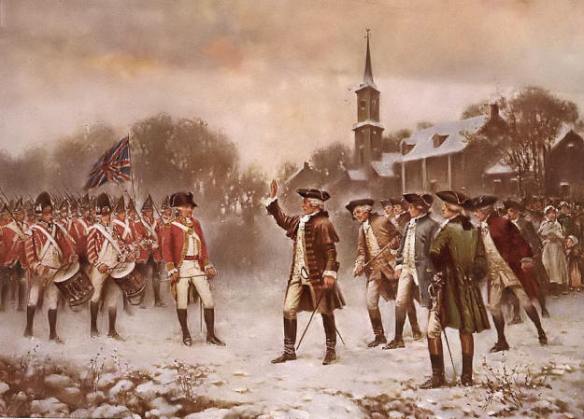After reaching Concord, the Redcoats found themselves surrounded by thousands of armed and angry militia. The march back to Boston, 20 miles away, became a fierce, running battle all through the day. From behind trees, houses, and stone walls, militiamen fired at the troops, who burned houses along the way and often counterattacked.
Dr. Prescott had reached Concord at 11:00 A.M. with his warning; alarm bells had summoned the militiamen. Reuben Brown rode to Lexington, heard the gunfire, and returned with the news of battle there. About 150 minutemen gathered to confront the approaching British troops. They dispersed when the troops came into sight and reassembled at Punkatasset Hill north of the Concord River. As the British troops took stations at Concord’s North Bridge, searched Col. John Barrett’s house for arms, or refreshed themselves in the local taverns, Patriot reinforcements arrived from nearby villages. The militiamen descended from Punkatasset Hill to a ridge near the North Bridge. Alarmed to see that the British had set fire to Concord’s courthouse and a blacksmith shop—although the soldiers quickly doused the flames—Barrett’s adjutant roused the Patriots to defend the town. Led by Barrett, Maj. John Buttrick, and Lt. Col. John Robinson of Westford, the Patriots advanced as two fifers played “The White Cockade.”
In command of the British troops at the North Bridge, Capt. Walter Laurie withdrew his men to the east end of the bridge and sent a messenger to Colonel Smith for reinforcements as the minutemen gathered at the bridge’s east end. Laurie’s troops opened fire, wounding an American. A second British volley killed two and wounded two among the Patriots; return fire killed three redcoats and wounded several others, including officers, causing the British to fall back in disarray to Concord. Lacking the discipline to mount an offensive, the Patriots allowed the entire British company to reform and to begin marching back to Boston at noon. But as they proceeded the British suffered repeated musket barrages from patriots racing before them to fire from behind trees, stone walls, and houses.
At Meriam’s Corner the British fired a warning volley at Meriam’s house, and the unexpected return fire killed two soldiers and wounded others. As the retreating soldiers crowded onto a bridge, rebel shots felled many of them. For 16 miles the minutemen harassed their enemy, sending the redcoats into a panicky retreat. Near Lexington the rebel firing wounded Colonel Smith and caused Major Pitcairn’s horse to bolt. As the frazzled redcoats staggered onto Lexington Green, expecting the worst, a force commanded by Lord Percy arrived from Boston to their rescue. The troops struggled back through Cambridge, constantly harried by the Patriots. Enraged by the sniping, the redcoats attacked homes, killed the males they found, and looted and burned. They finally reached safety at Bunker Hill and Breed’s Hill in Charlestown, protected by the guns of the British fleet. In the Battle of Concord and the British retreat, the Patriots lost 49 men, with another 46 wounded; the British had 72 dead and 201 wounded. The final toll perhaps seemed comparatively light, but the shots fired during and after the battles of Lexington and Concord would echo for years as the opening volleys of the American Revolution.
#
. . . On these companies’ arrival at Lexington I understand from the report of Major Pitcairn who was with them and from many officers that they found on a green close to the road a body of country people drawn up in military order with arms and accouterments and, as appeared after, loaded; and that they had posted some men in a dwelling and meeting-house. As our troops advanced towards them without any intention of injuring them further than to inquire the reason of their being thus assembled, and if not satisfactory to have secured their arms, but they in confusion went off principally to the left. Only one of them fired before he went off and three or four more jumped over a wall and fired from behind it among the soldiers, on which the troops returned it and killed several of them. They likewise fired on the soldiers from the meeting and dwelling-house: we had one man wounded and Major Pitcairn’s horse shot in two places. . . . While at Concord we saw vast numbers assembling in many parts at one of the bridges. They marched down with a very considerable body on the light infantry posted there. On their coming pretty near, one of our men fired on them which they returned, on which an action ensued and some few were killed and wounded. In this affair it appears that after the bridge was quitted they scalped and otherwise ill-treated one or two of the men who were either killed or severely wounded, being seen by party that marched by soon after. . . . On our leaving Concord to return to Boston they began to fire on us from behind the walls, ditches, trees etc., which as we marched increased to a very great degree and continued without the intermission of five minutes altogether for I believe upwards of eighteen miles, so that I can’t think but that it must have been a preconcerted scheme. . . . Notwithstanding the enemy’s numbers they did not make one gallant attempt during so long [an] action, though our men were so very much fatigued, but kept under cover on all occasions where much danger.
Lt. Col. Francis Smith, from his report written at Boston and submitted to Lt. Gen. Thomas Gage on the battles of Lexington and Concord, April 22, 1775, in K. G. Davies, ed., Documents of the American Revolution, vol. 9, pp. 103–104.
